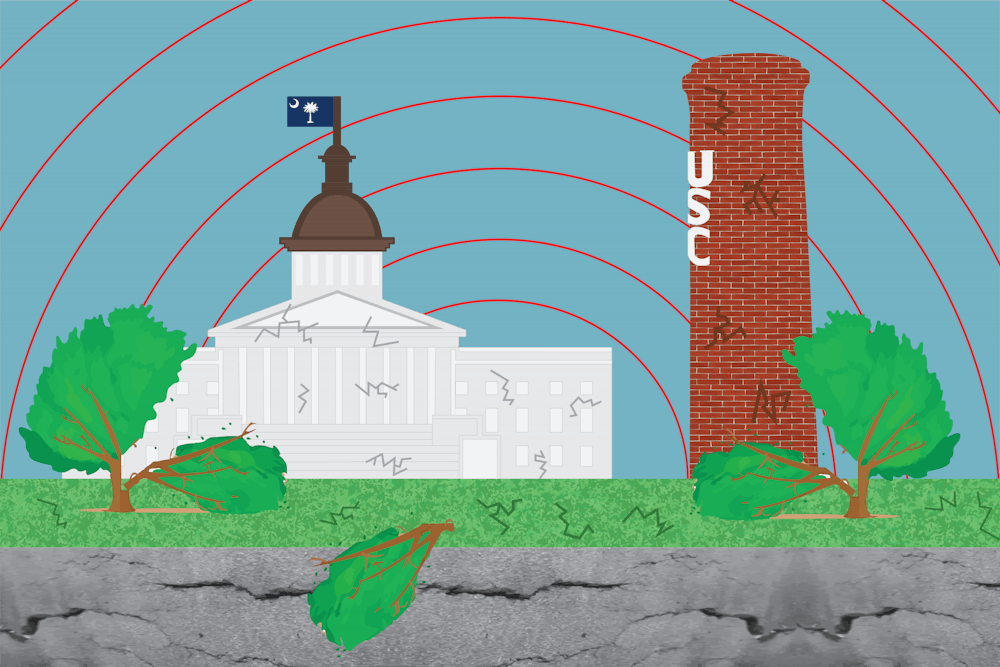Experts are not entirely certain what has caused the recent increase in seismic activity in the Columbia area. While small earthquakes are not uncommon in the Palmetto State, experts say that they are not cause for much worry.
Over the past few weeks there have been 16 confirmed earthquakes in South Carolina, with the largest being a 3.3 magnitude earthquake on Dec. 27. Dr. Steven C. Jaume, an associate professor of geology at the College of Charleston, said that some of the other earthquakes were too small to be located or recorded.
According to Thomas Owens, a professor in the department of Earth, Ocean and Environment at USC with a specialization in seismology, these earthquakes are nothing to be concerned about. Owens also said that they do not predict or increase the probability of a larger earthquake that could possibly cause damage.
The lack of information that comes from this series of earthquakes not only makes them hard to predict, but also makes it hard to identify the cause of them.
"It certainly has a cause. There's something in the earth that is causing these earthquakes to happen here and now. Probably, there's some sort of structural feature in the crust in the Lugoff—Elgin area, where basically either an old fault or some sort of geological boundary, that would be, maybe, think of it as a zone of weakness or something like that,” Phillip Crotwell, a research associate in the department of Earth, Ocean and Environment at USC, said.
While the definite cause of these earthquakes and why they are happening now is unknown according to Crotwell, Owens says these small earthquakes could be caused by older faults.
These older faults were created by tectonic events such as the building of the Appalachian Mountains, Owens said. They don’t necessarily cause earthquakes, but create weaker areas where stress fields can become aligned and produce some small earthquakes from time to time as a small release of energy.
Owens described these stress fields like a shelf with heavy books placed in the middle.
"Two things are gonna happen. It's gonna, you know, you'll see your bookshelf is kind of pressed down a little bit, it's arced, right? So it's deformed by that pile of books, but the other thing that happened is that some of the pressure that those books are putting on is absorbed or stored by the, in the shelf itself,” Owens said.
Ownes added that another reason for there to be little concern about the recent earthquakes is because Columbia is not located on an active plate boundary.
An active plate boundary is where there is some sort of interaction between two tectonic plates like on the West Coast and in California. There is reason for some concern for seismic activity in that area because that boundary can create some strong earthquakes, which is not the case for South Carolina, according to Owens.
Small earthquakes are not uncommon in South Carolina, with 10-15 recorded annually and 3-5 strong enough to be felt, according to the South Carolina Emergency Management Division.
Jaume said that these recent earthquakes serve as a reminder that South Carolina is earthquake country.
In 1886, a major earthquake in Charleston damaged or destroyed many buildings and killed 60 people, according to the United States Geological Survey. Damage was reported as far away as Ohio.
However, Jaume stressed the importance of knowing what to do if there is an earthquake large enough to cause damage.
“So, number one, drop to the ground. If you're around the ground, you can't be knocked down? Right? You're already on your hands and knees. Two: Cover; find a desk, a table, against the wall away from a window somewhere, maybe, against a piece of heavy furniture that won't tip over on you, you have to be aware of that,” Jaume said.

